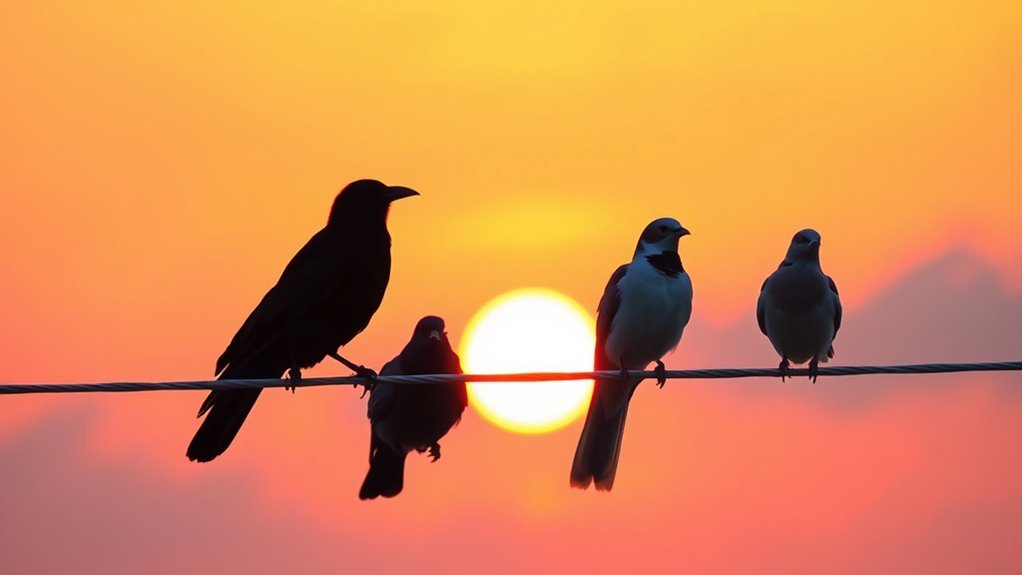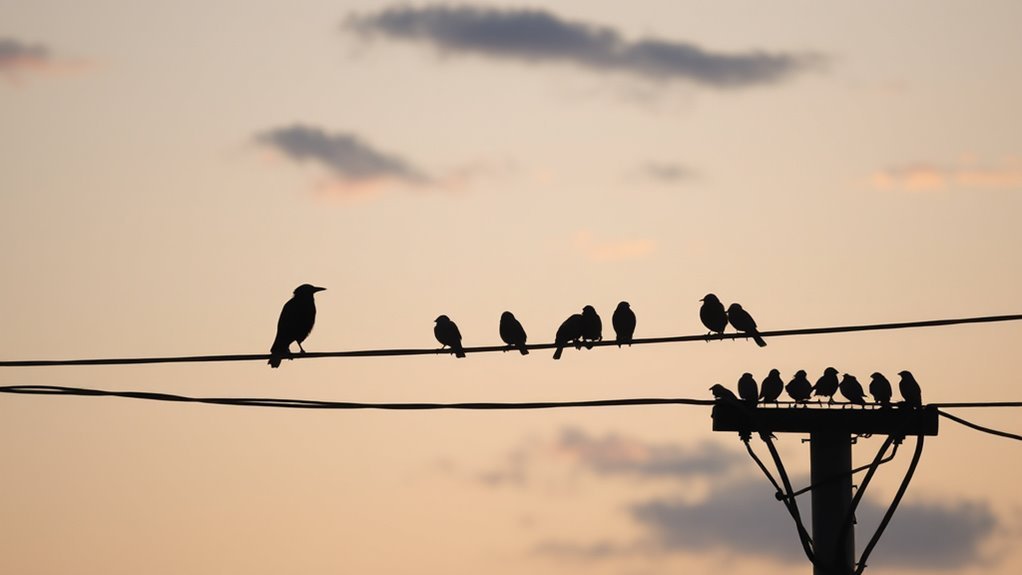The Symbolism of Birds on Wires Explained
As you watch birds on wires, think about what they represent in busy city life. They show freedom but also highlight connections in shared spaces. The delicate shapes of birds stand out against concrete and raise questions about our social connections. What do these gatherings say about how we interact in a world that feels disconnected? The answers may reveal important insights about the relationship between nature and humanity.
Key Takeaways
- Birds on wires symbolize a balance between freedom and urban life, representing the elegance of nature amidst city structures.
- Their flight patterns reflect desires for liberation and escape from daily routines, evoking feelings of adventure.
- Communication behaviors among birds illustrate social structures and connections, emphasizing the importance of community and relationships in nature.
- In art, birds often symbolize aspirations, freedom, and cultural values, linking human emotions with the natural world.
- Observing birds can elicit feelings of togetherness or solitude, highlighting the contrast between physical presence and emotional connections.
The Aesthetic Appeal of Birds on Wires

Birds sit on wires, creating an eye-catching scene that reflects city life. Their balance shows elegance, blending freedom with the structured urban environment.
Watching them move along these thin lines, you see not just birds but a symbol of connection and community in city living. They offer a brief glimpse of beauty amid daily chaos, reminding us that tranquility can exist even when life is hectic.
In their stillness, a moment of peace emerges, stirring a desire for belonging in a world that often feels isolated. They encourage us to stop, think, and appreciate our surroundings.
Symbol of Freedom and Escape
Birds on wires symbolize freedom and escape. Their smooth flight patterns show grace as they soar and dive. Each move suggests liberation, encouraging you to break free from your limits.
They react quickly to danger, reminding you to seize moments and embrace the unexpected. You may feel a desire to experience that same freedom, imagining what it's like to break away from the everyday.
Watching birds reveals your inner wish to fly, escape, and explore new horizons.
Connection and Communication Among Species

Birds perched on wires exhibit interesting communication behaviors. They engage in a lively exchange, showcasing how different species convey messages. A flick of a wing or a specific call can indicate danger, food, or mating intentions.
These interactions create bonds that go beyond survival and foster a sense of community among various birds. Observing these exchanges reveals their social structures through each chirp and movement.
Birds on wires highlight the connections in nature and encourage us to recognize our own relationships within the larger web of life.
The Balance Between Nature and Urban Life
As cities grow, the balance between nature and urban life becomes clearer. You can see birds on wires, showing nature's strength amid buildings.
Urban areas provide homes for wildlife, proving nature can thrive in busy places. Parks and green spaces offer refuge for animals and a pleasant environment for humans.
Appreciating this balance can enhance your city experience. It allows you to enjoy the moments when birds fly, connecting you to a peaceful way of living.
Welcoming nature in cities encourages you to build a deeper connection, showing that every living being contributes to our environment.
Cultural Interpretations of Birds in Art

Birds symbolize freedom and connection in art. Different cultures portray them with unique meanings. Indigenous art often shows birds as spiritual beings that link the earthly world with the divine. In Western art, birds may symbolize aspirations and individualism. These interpretations encourage you to reflect on your own experiences and beliefs.
The way birds are depicted reveals much about societal values and personal desires. Engaging with these artistic expressions fosters a sense of belonging, as themes of freedom and hope unite us across cultures.
Each representation of birds invites you to explore shared human experiences and find common ground in our diverse lives.
Social Gatherings and Community Dynamics
Social gatherings show how communities connect and build relationships. When you attend a gathering, you can feel the excitement—people laughing, talking, and meeting one another.
These social interactions strengthen existing relationships and create new ones. Some groups form around shared interests, while others step outside their usual circles to connect. Each interaction adds to a sense of belonging and highlights the importance of these events for building a strong community.
As you watch conversations flow, you see trust and understanding grow, fostering a supportive environment where everyone feels valued and part of the community. Social gatherings are vital for our shared human experience.
The Role of Birds in Human Folklore
Throughout history, birds have symbolized freedom, change, and a link between the earth and the divine. In folklore, birds tell important stories and lessons.
Here are a few mythical birds and their meanings:
- The phoenix represents rebirth and renewal.
- The owl symbolizes wisdom and intuition.
- The raven is associated with mystery and change.
- The sparrow reminds us of humble beginnings.
- The swan stands for grace and beauty in tough times.
These stories encourage reflection on your own journey. Like birds, you can rise above challenges and embrace change.
The bond between humans and birds enriches storytelling across cultures, deepening our sense of belonging.
Perspectives on Loneliness and Togetherness
The sound of birdsong can create feelings of connection but may also highlight loneliness for those listening alone.
Birds sitting on wires appear united, yet their movements can remind you of your own solitary experience. Watching them reflects the idea of togetherness in nature while sparking a desire for companionship.
You may think about the connections in your own life—how people can physically share a space but still feel distant. Observing these birds can motivate you to build stronger relationships, turning your feelings of loneliness into a quest for genuine togetherness.
Each bird serves as a symbol of the connections you wish to form and the bonds that await you.
Environmental Changes and Bird Behavior
Every season causes changes that affect bird behavior. You can see how migration patterns and habitat loss impact their lives.
Birds adapt to new conditions, which can lead to surprising actions. Here are key changes to notice:
- Migration patterns shift, altering arrival and departure times.
- Competition for resources increases as they become limited.
- Nesting sites change because of habitat loss.
- There's a rise in bird sightings in urban areas.
- Feeding habits adjust based on food availability.
These changes show bird resilience and reflect larger environmental shifts.
The Influence of Technology on Avian Habitats
As technology develops, it significantly affects bird habitats and their interactions with the environment. Urban expansion often leads to smaller nesting areas for birds. This creates pressures on bird populations by limiting their living space.
Technological changes also disrupt migration routes and food availability. Habitat fragmentation worsens as green areas decrease, resulting in fewer choices for birds.
Additionally, electric infrastructure, such as power lines, increases the risk of collisions and limits safe places for birds to rest.
Understanding these changes is vital as they impact both birds and the ecosystems we share. By recognizing these effects, you can engage in conversations about sustainability and habitat protection, strengthening your connection to the birdlife around you.
Reflections on Life's Transience and Change
Life always changes. You may think about how impermanence influences our existence. When you see birds sitting on wires, you're reminded of life's fleeting moments. You might notice:
- The change in every season
- The joy in brief meetings with friends and family
- Each sunrise as a chance for new beginnings
- How laughter comes and goes
- The fun found in spontaneous adventures
These moments show beautiful impermanence and encourage you to enjoy each experience.
Recognizing this change helps you appreciate deeper connections and treasured experiences. This leads to a greater sense of belonging in life's ongoing journey.
Frequently Asked Questions
Why Do Birds Prefer Certain Wires Over Others?
Birds often choose specific wires for three main reasons: safety, height, and food availability. Their wire preferences show behaviors and adaptations that help them survive. This observation helps us appreciate the natural world and how birds interact with their environment.
Do Different Bird Species Gather on Wires Together?
Different bird species often sit together on wires. This behavior shows their social interactions and helps us understand how they coexist. It creates a sense of community among them. Observing these gatherings can be interesting and enjoyable for bird watchers and nature lovers.
How Do Weather Conditions Affect Birds on Wires?
Weather affects birds on wires in clear ways. Wind can make them sway, while changes in temperature can impact how many gather together. Watching these changes in their behavior can enhance your understanding of their role in the environment.
Are There Specific Times of Day Birds Use Wires?
Birds often gather on wires in the morning for warmth and energy. In the evening, they move to roosting spots for safety and community as the day ends. These times highlight their social behavior and survival needs.
What Does Bird Behavior on Wires Indicate About Their Health?
When you see birds on wires, their behavior can show their health. Birds that appear relaxed and social are likely healthy. Birds that stay alone or act agitated may be stressed, indicating possible health problems that need care. Observing these behaviors can help you understand their well-being.

Hello, I’m Emily Price, the founder of Birds Affection. As a passionate bird enthusiast and spiritual seeker, I’ve always been fascinated by the symbolic meanings and mystical connections between birds and our lives. On this website, I share my knowledge and insights on the spiritual significance of various bird species, exploring their roles as messengers, guides, and teachers. Through my writing, I aim to inspire and educate others on the profound wisdom and beauty that birds bring to our world. Join me on this journey as we delve into the enchanting realm of bird symbolism and discover the hidden meanings behind these magnificent creatures.







